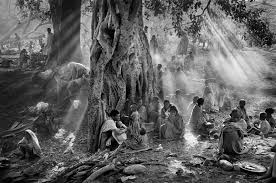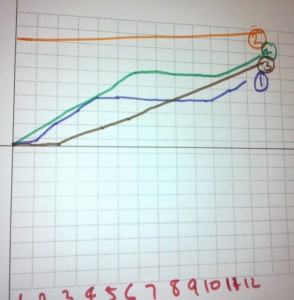As the only mature age student in the class, I always find the first week of the Media Studios a daunting prospect, namely the age difference and all the youth culture references that go with it. Also, as the oldest person in the group, I’m very much aware that my co-students might think that I may want to dominate the group and often try to take a back seat approach when necessary.
Fortunately, with the students in our Podcast class, most of the time this wasn’t an issue and we found ways to work collegially. San and Tessa did take the lead as they seemed quite well versed with the medium of podcasts (like in setting the appropriate levels on the H4N recorder). We also bounced off ideas and there never seemed a point of conflict. We also had a lot of fun using the shotgun mic for recording sound effects and atmos. Thus, I quite enjoyed doing our first studio task together which was a story on my accident with a tram. I’d cut things before in Audacity but not something as complicated as recording voices from fellow students to fill in for characters. The end result was passable but as the voices didn’t quite match up in their energy or acting ability I had to ditch half of them. Time permitting, we would’ve have scripted out the dialogue. In the end with had ad-hoc recordings.
One of my favourite in-class prac exercises was recording atmos for our piece where we had to produce a story without dialogue. Choosing the horror genre before we set out saved us a lot of time and we aimed at capturing tropes often used in said genre: doors slamming, screams, heavy breathing etc. I was quite happy with my horror piece – the electric hum of an industrial complex, footsteps then the eerie heavy breathing (enhanced by applying backwards loops and reverb) and all ending with a climatic scream and sinister laugh. More challenging was adding dialogue to it and in a master class, Catherine pointed out that I had the levels up to high on the atmos and sound effects as they drowned out the action and dialogue of the protagonist. Looking at my timeline, she also suggested using fewer tracks so I could see where all my sound effect were (I had them on eight tracks and difficult to find).
Putting together the podcast essay (Project Brief 2) was extraordinarily time consuming. I focused on Shit Town, a southern gothic podcast focusing on a town eccentric in a small country town in Alabama. Finding the central thesis took some time and thankfully the issue of ethics was one I could research. While I think my script was good (bookending the characters talking about the maze) my delivery sounded wooden and stilted and overall sounded somewhat boring (to me at least!). I think I was trying to sound like a radio journalist rather than myself although that in itself is difficult. Though I did numerous takes, practice and learning to relax would solve my awkward voice.
Project Brief 3, the video essay, was far the most challenging task. Our group (Natalie, Armin and Jennifer), decided to go for the web series ‘Bruce’. Making the essay visually interesting was not an easy fix so I thought an interview with the director and the writers would flesh out more of the underlying reasons why they had released the show youtube as they are no financial returns. After all, they’d already had huge success with Wilfred which had been remade in the USA and starring Elijah Wood. I set up the interviews – the director Tony Rogers was more than happy to meet us while the writers were slow to respond but I did manage to interview them over the phone.
As ‘Bruce’ is about the first convicts in Australia, Catherine suggested we interview the director, Tony Rogers, at the Polly Woodside. Tony was most obliging and he met us on a horribly windy rainy day. We started filming but then we realised we had some technical issues – the mic wasn’t picking up any sound and both the batteries were nearly flat. We had to reshoot, charge up the batteries and what’s more, I had to reformat the footage because it had been filmed in MP4 into mp4 before I could send it off to Jennifer and Natalie to edit. This took several hours! What we learned from this experience is to not to use Building 8 video cameras (they’re crap!) and to check everything is working before we begin. Another snag that we had was that Tony, who had promised he had all the time in the world, suddenly didn’t and we had to make do with the footage that we had. Natalie and Jennifer did the best they could with the available footage though the background music, in the end, did need to be taken out completely in parts, though this never eventuated by the time we had our assessment.
The last project, PB 3, pitching a podcast series, was extremely valuable. I’ve been writing a children’s novel for the past three years Invasion of the Bottom Snatchers and so the medium of a podcast was perfect and easy to condense. I pitched my idea to our guests, Bec Hornsby from 3RRR and Steiner Ellingsen from Melbourne Webfest. They were both very enthusiastic about it, which was quite heartening. Bec suggested I approach the ABC while Steiner wanted me to make my show into an animation (he was quite animated about it himself!).
What’s also been mind-expanding are the podcasts. I wouldn’t have normally listened to podcasts if I hadn’t done this course. Some of my favourites were My Dad Wrote a Porno, Wireless Nights by Javis Cocker, Shit Town and Serial. I particularly liked Wireless Nights as I felt like I had been transported into some ethereal dream: Cocker’s hypnotic voice addressing an imaginary character that remains ambiguous – is it really a character or is he addressing us? He chooses to interview people who are ordinary but illuminates their extraordinariness. He is the story while at the same time not being it. Brilliant!
My Dad Wrote a Porno showed how an informal podcast can be – 3 friends drinking wine around a table while Jamie Morton treats them with cringe-worthy passages of his father’s erotic novel. I liked its relaxed conversational tone –a real conversation but entertaining nonetheless.
Finally, what I learned in the podcast studio overall, apart from the technical aspects such as framing, lighting, microphone placement, working in group and story development, was the potential of stories and how they can be told in interesting ways. Both mediums, visual and aural, play to their own strengths, though I would say I prefer podcasting as our imaginations can take us to places that filmed visual imagery cannot. The podcast studio has given me confidence where there had been none before in this field.









